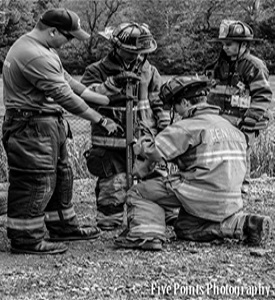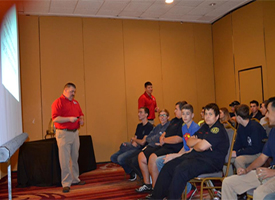

Photos courtesy of Five Points Photography.
By Dennis Walton
The fire service is getting younger by the minute, but our job is not. Nothing will beat 20-plus years of on-the-job experience, but veteran firefighters are retiring or, worse, leaving the job because of illness or injury. It is now up to the relatively young members to teach, guide, and mentor an even younger firefighter.
One of the fire service’s biggest problems is peeling young members off of their computers, getting them out of the house, and getting their hands dirty. When I was growing up, it was common to be outside or in the garage with my father as he worked on cars, mowers, or anything else that needed to be fixed. This has been replaced by making appointments with smart phones to get cars serviced or even having the car’s computer system do it for you without even getting up from your video game. We must take these firefighters out of their climate-controlled room and get them onto weathered training grounds.
Another factor interfering with young firefighter development is the independent education plan (IEP), which can be available to kids as early as age 3. An IEP offers special needs to help a student move forward in his education. It identifies learning characteristics specific for the individual. At times, an IEP can be as simple as having a test read to the child or taking a picture of the classroom board instead of having him take notes. Having an instructor comfortable with reading a quiz or test to a student can go a long way for that student.

What does it take to teach and mentor this young, uniquely educated group? When the new firefighter shows up for his first day of academy or firefighter I program, have a system in place that makes sure he leaves with the same knowledge and education as everyone else. You must have your basic class outline ready to go and be able to adapt to the abilities of the members that show up on the first day. Also, prepare a PowerPoint™ presentation that involves the students more than if they were to just read writing on a screen. If we put too much information on a slide, the student can read it at times faster than we discuss it, and they will lose interest waiting for us to catch up. Use the “Rule of Seven” when developing PowerPoint slides—No more than seven works, seven lines, or seven items per slide. Pay close attention to your slide design. Often, instructors use too many transitions, flashy colors, or other tricks to their slides. Although these may appear to look good, they take away from the message and, often, will be more distracting than helpful. Instruct the students to the level needed for them to achieve, not to completely “teach to the test.” The more you teach, the easier this will become.
RELATED: Brunacini on Advice to Young Firefighters ‖ Kastros on Inspiring and Motivating Firefighters ‖ Tracy on Firefighters Mentoring Firefighters
You must also keep up with technology. For example, incorporate “apps” or electronic textbooks and study guides into your curriculum. Using technology keeps the students focused and is more relatable to them. Some apps feature step-by-step directions to the skills, videos, study flashcards, and practice tests with which you use. One example is the Fire Engineering app, which allows you to access “Training Minutes” videos and stay up-to-date with fire service news and advancements. Fire Engineering also offers beneficial resources such as its daily newsletter, Training Community, daily BlogTalkRadio shows, and weekly Google hangouts, just to name a few. Instructors can purchase and even rent videos to pass onto the students and also become a member of the Fireground Training network, where they can download training notes and drills to assist them in the delivery of their program. Other helpful apps include Haz Mat response guides, pump flow calculations, and technical rescue guides.
There is no app for helping students get their hands dirty; time, focus, and patience all work together to create these real-world or simulated scenarios.
Demonstration is also a key to this teaching. Showing the students how and why we do things the way we do goes a lot farther than telling someone how to do it. To involve the students, set up skill stations. This way, the larger group can be split into smaller groups and be rotated through the different skills. This allows them more one-on-one time with the instructor and more opportunities to practice their skills. At the end of the day, you can start putting the skills together to show how each little step adds up. Have a “Plan B” and even a “Plan C” in place to make sure you can assist students if you see them struggling.


Repetition is also necessary. As it is with school sports, the more they practice, the better they will get. “Practice makes perfect” can be an accurate phrase because the more you do something, you build up that procedural memory, and your brain can quickly instruct your muscles to carry it out. That muscle memory doesn’t judge whether you’re doing good or bad, however, and so if you practice poorly for hours on end you’re going to be really good at making the same mistakes over and over again.
Motivation plays a pivotal role in all of this. Keeping the students’ heads in the game and positive feedback on their performance will go a long way. Create competitions between students and groups and between instructors participate, Some of the best motivation can be seeing the instructors get involved.). Adding other incentives or rewards also increases motivation and enhances the learning environment. If the students see instructors getting our hands dirty with them, it will make them feel more a part of the team.
We must keep the knowledge of the 20-year member going by adapting to the technology and background of any member that walks through our doors.
Dennis Walton is a career firefighter for the Allentown (PA) Fire Department amd an instructor with On Scene Training Associates.


